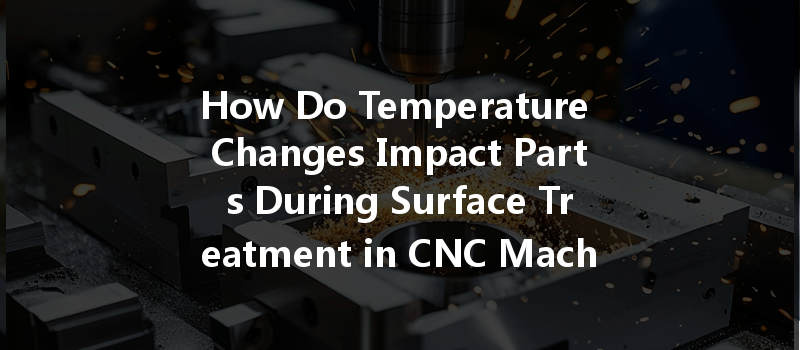*
—
Welcome to our comprehensive discussion on a critical aspect of CNC machining that often goes unnoticed—the impact of temperature changes during surface treatment processes. Here at YL Machining, we are committed to elevating the understanding of complex machining phenomena, and today, we delve into how temperature fluctuations can make or break your surface treatment outcomes.
Surface treatment is the final frontier where aesthetics meet functionality, acting as the protective shield and enhancing the performance of precision-made components. The delicate balance of temperature in these processes can dictate not just the longevity of the part but also its mechanical properties and overall performance. In this article, we’ll explore the intricate relationship between temperature and surface treatments, aiming to arm you with knowledge that could substantively influence your machining practices.
Let’s embark on this insightful journey!
2.1 Definition of Surface Treatment
Surface treatment refers to various processes applied to a material’s surface to modify its physical and chemical properties, enhancing characteristics like corrosion resistance, appearance, and wear resistance. Common treatments include anodizing, electroplating, and various coatings.
2.2 The Role of Temperature in Surface Treatment
Temperature acts as a critical parameter in the kinetics of physical and chemical reactions that occur during surface treatments. While some processes may require elevated temperatures to be effective, others could suffer if exposed to excessive heat. The ability to manipulate temperature accurately can lead to optimal treatments, resulting in components that meet and exceed performance expectations.
3.1 Anodizing

Anodizing is an electrolytic passivation process that enhances the natural oxide layer on metal surfaces, particularly aluminum. It requires a specific range of temperatures to achieve desired thickness and surface finish.
3.2 Electrophoretic Coating
This process involves depositing paint particles onto components immersed in a liquid medium by applying an electric charge. Ambient temperature is vital; too high may lead to dripping, while too low could result in inadequate adhesion.
3.3 Electroplating
Electroplating is a method that deposits a layer of material onto a component to improve its surface qualities. Temperature impacts ion activity and deposition rates, which in turn affect the homogeneity of the coating.
4.1 Impact on Material Properties
Temperature influences the microstructure and mechanical properties of the materials involved. Higher temperatures can lead to diffusion processes that may alter hardness and toughness.
4.2 Chemical Reactions and Temperature
Many chemical reactions involved in surface treatments exhibit temperature dependence per the Arrhenius equation, indicating that reaction rates rise with temperature. However, too high a temperature can make these reactions uncontrollable, leading to poor-quality finishes.
4.3 Equipment Thermodynamics
CNC machines and treatment baths must be maintained within an optimal temperature range to ensure efficient operation. Temperature fluctuations can lead to equipment malfunction or degraded quality of the treated surface.
5.1 Case Study: Anodizing Aluminum Alloys
In a recent experiment at YL Machining, aluminum alloys were anodized at temperatures of 18°C, 22°C, and 26°C. The optical microscopy results indicated that the layers obtained at 22°C yielded the best combination of thickness and uniformity, while the 26°C samples showcased gassing with uneven surfaces.
5.2 Case Study: Surface Treatment of Stainless Steel
Stainless steel components were treated using electroplating at varying temperatures. Data showed that a temperature of 30°C produced the highest quality finishes, with significantly lower defect rates when compared to processes run at 20°C or 35°C.
6.1 Temperature Control Measures
Implementing real-time temperature monitoring systems can mitigate risks associated with temperature variations. Automated systems can trigger alarms or actions when critical thresholds are crossed.
6.2 Equipment Calibration and Maintenance
Regular calibration of CNC machines and surface treatment equipment is pivotal. Equipment that adheres to strict calibration schedules typically experiences fewer temperature-related fluctuations.
6.3 Pre-Processing and Post-Processing Temperature Checks
Conducting temperature checks before and after treatment processes helps in identifying any issues that may arise during the process. This step can be crucial to achieving consistent results.
7.1 Common Problems Encountered
Temperature variation can arise from several sources, including ambient environmental conditions, equipment malfunction, or procedural errors.
7.2 Innovative Solutions from YL Machining
Our team at YL Machining continues to innovate by incorporating smart technology solutions that allow us to predict temperature variations and respond proactively.
As artificial intelligence and machine learning technologies evolve, we foresee enhanced temperature management systems where predictive analytics will allow for adjustments in real-time, thereby improving surface treatment outcomes exponentially.
The importance of temperature management in surface treatment processes cannot be overstated. It serves as the foundation for achieving the desired properties and performance of matched materials. Through the lens of YL Machining, we hope this exploration has equipped you with insights that will refine your approach to CNC machining and encourage further inquiry into optimizing your surface treatment practices.
Ultimately, the journey of surface treatments is not just about techniques; it is about the meticulous control of every element that plays a role in creating excellence.
Thank you for joining us on this enlightening path. Stay curious, and keep machining!






